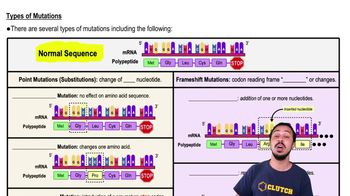For each of these statements about the genetic code, select True or False. a. T/F Wobble pairing accounts for the redundancy of the genetic code. b. T/F There are 64 different tRNAs that read the 64 possible codons. c. T/F All possible codons are used, but not all codons specify an amino acid. d. T/F Some codons are recognized by proteins, not by tRNAs.
Which of the following describes mutations? Select True or False for each statement. T/F Point mutations can occur in any DNA sequence. T/F Frameshift mutations can occur in any DNA sequence. T/F Neutral mutations depend on the degeneracy of the genetic code. T/F Deleterious mutations occur only in protein-coding sequences of DNA.

Verified Solution
Key Concepts
Point Mutations

Frameshift Mutations

Neutral and Deleterious Mutations

A minimal genetic code requires only 21 codons—one for each amino acid, and one for a stop signal. Given this, what advantage might be offered by having a code with 64 codons?
Imagine discovering a loss-of-function mutation in a eukaryotic gene. You determine the gene's nucleotide sequence from the start site for transcription to the termination point of transcription and find no differences from the wild-type sequence. Explain where you think the mutation might be and how the mutation might be acting.
In a particular bacterial species, temperature-sensitive conditional mutations cause expression of a wild-type phenotype at one growth temperature and a mutant phenotype at another—typically higher—temperature. Imagine that when a bacterial cell carrying such a mutation is shifted from low to high growth temperatures, RNA polymerases in the process of elongation complete transcription normally, but no new transcripts can be started. The mutation in this strain most likely affects: a. the terminator sequence b. the start codon c. sigma d. one of the polypeptides of the core RNA polymerase
Explain what's wrong with this statement: All point mutations change the genotype and the phenotype.
In what ways are a promoter and a start codon similar? In what ways are they different?
